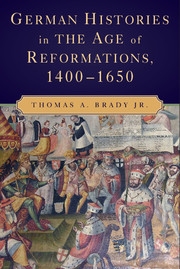Book contents
- Frontmatter
- Contents
- Figures, Maps, and Tables
- Acknowledgments
- A Note on Usages
- Map 1 The Empire in 1547
- Map 2 The Peace of Westphalia, 1648
- Part I The Empire, the German Lands, and Their Peoples
- 1 Reformations in German Histories
- 2 Shapes of the German Lands
- 3 Temporal Estates – Farmers, Traders, Fighters
- 4 The Church and the Faith
- Part II Reform of the Empire and the Church, 1400–1520
- Part III Church, Reformations, and Empire, 1520–1576
- Part IV Confessions, Empire, and War, 1576–1650
- Appendix
- Glossary
- Bibliography
- Index
4 - The Church and the Faith
Published online by Cambridge University Press: 05 June 2012
- Frontmatter
- Contents
- Figures, Maps, and Tables
- Acknowledgments
- A Note on Usages
- Map 1 The Empire in 1547
- Map 2 The Peace of Westphalia, 1648
- Part I The Empire, the German Lands, and Their Peoples
- 1 Reformations in German Histories
- 2 Shapes of the German Lands
- 3 Temporal Estates – Farmers, Traders, Fighters
- 4 The Church and the Faith
- Part II Reform of the Empire and the Church, 1400–1520
- Part III Church, Reformations, and Empire, 1520–1576
- Part IV Confessions, Empire, and War, 1576–1650
- Appendix
- Glossary
- Bibliography
- Index
Summary
There are the sacraments, which are both illuminating and purifying; there is the pastoral priesthood, which is both purified and purifying; and there is the faithful people, which is purified and does not purify …
Nicholas of CusaThe clergy, Bishop Adalbero's “those who pray,” belonged to the Church in a special way. These men and women embodied and tended the channels of grace between the two realms of St. Augustine's concept, the earthly city and the City of God. The clergy normally took pride of place in medieval schemes of social hierarchy and commonly formed the first estate in parliamentary bodies. One tradition of medieval teaching conceived the clergy in the broadest sense as a complete clerical society parallel to but distinct from the laity ordered into temporal or secular estates. This status was warranted, it was argued, by the clergy's guardianship of the sacramental, penitential, and intercessional ties both between God and His creatures and among His creatures.
The Church was the most regularly structured and best understood institution in late medieval Christendom. Its foundation comprised the medieval Church's greatest creation, which was not the papal monarchy or the universities but the network of territorial parishes that blanketed Christendom with a church in every place and a priest in every church. From this base the ecclesiastical system arose in tiers through territorial dioceses and their subunits (deaneries and archdeaneries), through provinces, and the papal government in Rome.
- Type
- Chapter
- Information
- German Histories in the Age of Reformations, 1400–1650 , pp. 49 - 68Publisher: Cambridge University PressPrint publication year: 2009

